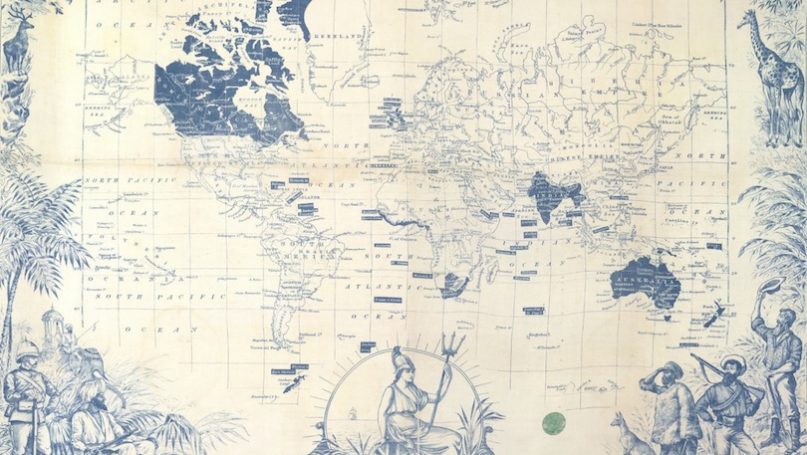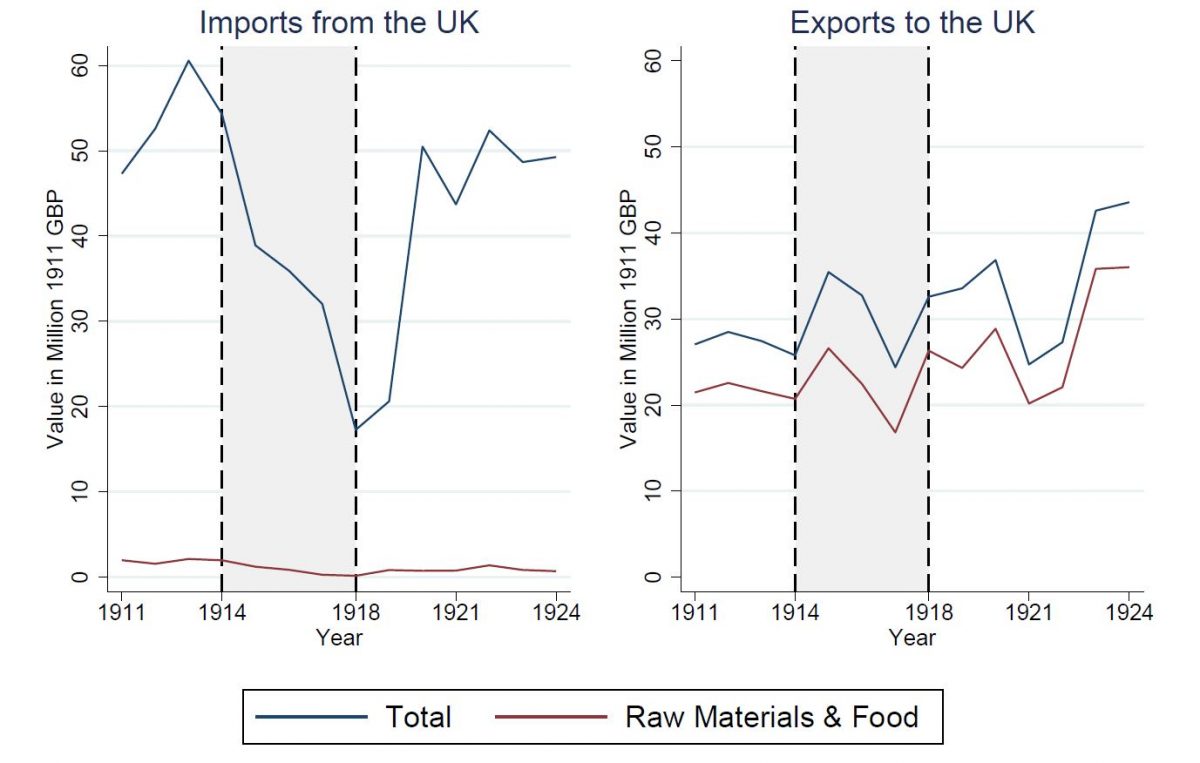Roberto Bonfatti and Björn Brey
 One common feature of European empires was the prominence of trade between the colonies and imperial power. This resulted in a pattern of specialisation whereby the colonies exported mainly primary products and imported mainly manufactures. The imperial powers encouraged this specialisation, which simultaneously benefited their consumers of primary products, producers of manufactures, and investors in colonial plantations and mines (see e.g. Findlay and O’Rourke, 2009). Accordingly, in the colony, this likely benefited consumers of manufactured products, and producers of primary products. From the colonies, however, two additional questions arise: did colonial trade limit industrial growth in the colonies? And did it reduce the colonies demand for independence, by making them dependent on trade with the imperial power?
One common feature of European empires was the prominence of trade between the colonies and imperial power. This resulted in a pattern of specialisation whereby the colonies exported mainly primary products and imported mainly manufactures. The imperial powers encouraged this specialisation, which simultaneously benefited their consumers of primary products, producers of manufactures, and investors in colonial plantations and mines (see e.g. Findlay and O’Rourke, 2009). Accordingly, in the colony, this likely benefited consumers of manufactured products, and producers of primary products. From the colonies, however, two additional questions arise: did colonial trade limit industrial growth in the colonies? And did it reduce the colonies demand for independence, by making them dependent on trade with the imperial power?
In Bonfatti & Brey (2020), we attempt to answer these questions empirically, in the context of early 20th century colonial India. We exploit the exogenous collapse in trade generated by World War I – which, as shown in Figure 1, more than halved Indian imports from Britain in real terms – to show that districts exposed to a greater 1913-17 decrease in imports from the UK experienced faster industrial employment growth in 1911-21, placing them on a higher level of industrialisation which is visible to these days (2011).
In the second part of the article, we exploit this exogenous increase in industrialisation levels to ask whether more industrialised districts lent greater support to the anti-imperial movement in the 1920s and 1930s. This analysis is based on a classical argument on the role of commercial versus industrial colonial groups in supporting or opposing imperialism, which has been reformulated recently by Bonfatti (2017). The argument goes as follows: because empires were trade-enhancing institutions, trade disruption would be one of the costs of rebelling against them. However, such disruption would affect different colonial groups differently. For commercial groups, involved in the export of primary products to the imperial power, trade disruption would imply a cost. In contrast, for industrial groups involved in import substitution, it might even imply a gain. Thus, commercial groups should support the empire, while industrial groups should oppose it. It follows that greater colonial industrialisation, by making the industrial groups more influential, should make a colony more rebellious. Within India, more industrialised districts should lend greater support to the anti-imperial movement.
We measure support for the anti-imperial movement in India at two key dates in its history: 1922 and 1937. The first year marked the end of the Non-Cooperation Movement of the Indian National Congress (INC). This was Gandhi’s first attempt to resist British rule through non-violence. In the summer of that year, the INC run an internal survey asking local party members how in favour they were of civil disobedience against the British (see Indian National Congress, 1922). We observe the responses of up to 252 local party members, scattered all over India. Our first measure of anti-imperial feelings will be the average response of INC members in a district. Figure 2 illustrates the considerable geographical variation across INC members in supporting the start of further civil disobedience. Fifteen years later, the INC had become the mass political party that would eventually lead the country to independence (1947). In 1937, a provincial election was held, the first to be run on a significant franchise, and also the first to be contested by the INC with full force. The result was a landslide for the INC, which formed governments in the majority of provinces (see India Office, 1937). Our second measure of anti-imperial feelings will be the share of seats won by the INC in a district.
We find that districts that had industrialised more because of the WWI trade shock featured stronger support for civil disobedience in 1922, and were more likely to elect an INC representative in 1937. A one percentage point increase in the industrial employment share is estimated to result in a 54% stronger support for civil disobedience in 1922, and a 6% higher probability of electing an INC representative in 1937 (see Bonfatti & Brey, 2020). These are large effects. They suggest that although the INC’s success was ultimately explained with its capacity to mobilise the rural masses due to the overall low levels of industrialisation in India. Industrialisation levels, per se, did have a large impact on support for the anti-imperial movement.
Our results suggest that colonial trade did limit industrial growth in India, as shown by the fact that its interruption in 1913-17 led to a period of faster industrial growth and a persistently higher level of industrialisation. At the same time, colonial trade did help to keep India under control, as shown by the fact that its interruption in 1913-17 led to stronger support for the anti-colonial movement in the 1920s and 1930s.
To the extent that our results can be generalised, they have three important implications for our understanding of the economics of colonial empires. First, while colonial trade may have had some positive implications for the colonies – amongst which the modernisation of some parts of their economies – it likely hurt their long-run industrial growth. Second, our results provide a new way to rationalise the wide range of anti-industrial policies (including imperial preferences) that, sooner or later, all imperial powers adopted in their colonies. We can think of two main reasons why the imperial powers might have knowingly wanted to discourage industrialisation in the colonies. The first and most obvious is that it would imply greater competition for their industries. The colonies offered important markets for the imperial powers’ manufactures, providing domestic tax revenues and employment to a considerable extent. Our results suggest an additional mechanism. The promotion of industrialisation would have led to colonial manufacturers being a more influential group in colonial politics. This would have made the colonies more assertive, and potentially more likely to rebel.
Finally, our result may explain why the most successful industrial power of the 19th century, Britain, was also the most successful imperial power: its industrial productivity boosted trade with the colonies, which in turn helped it to keep the colonies under control. In the case of India, British industrial productivity led to a century-long process of deindustrialisation: a dominant producer and exporter of handcrafted cotton textiles until the 18th century, India was outcompeted by the industrial revolution in Britain (see e.g. Gupta & Roy, 2017). This process not just changed the economic structure of the Indian economy, but likely also replaced producers of manufatures more supportive of the anti-imperial movement with producers of raw materials and food that had less to gain and more to lose from the anti-imperial movement. To summarise, we find evidence that the pattern of colonial trade played an important role in keeping empires together. In particular, we find evidence that India was able to industrialise when it was protected from British imports during WWI. In turn this industrialisation had a large, positive impact in support of the anti-imperial movement in India.
Figure 1. Trade between India and the UK 1911–1924

The blue line above denotes total Indian imports (exports) from (to) the UK in million 1911 British pounds. The difference between the blue and red line denotes Indian imports (exports) of manufactures from (to) the UK. The red line denotes Indian imports (exports) of raw materials and food from (to) the UK. Source: Bonfatti & Brey (2020)
Figure 2. Support civil disobedience across British India

Figure 2 shows the average support for civil disobedience across British Indian districts in 1922. Pro responses coded as 1 and against coded as 0 for each individual INC member in a district. The darker the colour, the more support was recorded for further civil disobedience. White areas represent no information available. Source: Bonfatti & Brey (2020)
No comments:
Post a Comment